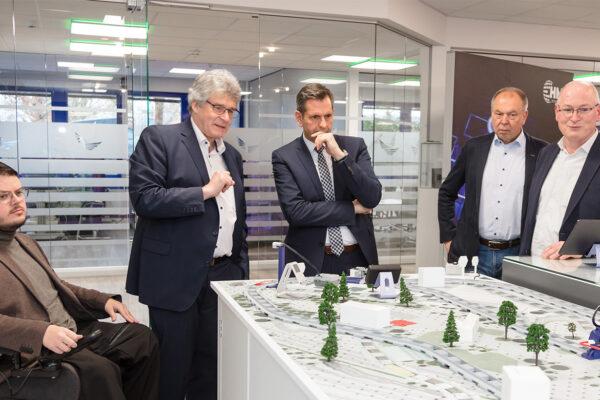Why is the 5G technology so interesting to the mission-critical sector?
“The 5G standard, that is, the 5th generation mobile radio network, should distinguish itself above all through its application-appropriate flexibility. With data throughput of up to 10 GB per second/participant, 99.99% reliability, and the ability to support up to 1 million devices per square kilometer, 5G will probably set standards. For this, 3GPP, the worldwide cooperation of committees for the standardization of 5G, promises long life of the radio sensors, which should be able to go 15 years without a battery change. The reaction time (latency time) is less than 1 ms. Thanks to network slicing, that is, virtual networks operated in parallel based on the same physical infrastructure, 5G can react quickly and flexibly to the requirements of future safety-critical applications. Thanks to the New Radio 5G air interface, 5G can be used on every frequency band between 450 MHz and 90 GHz, and this with only an air interface. With Multi Edge Computing (MED), calculation of the data traffic and services is shifted from a central cloud to the network periphery, and therefore much closer to the user. Instead of sending all data to a central cloud for processing, the data is analyzed, processed, and saved on the so-called network edge. Thanks to the recording and processing of data much closer to the user, the latency, that is, the system’s reaction time, is reduced greatly and enables a real-time reaction of the system for applications with high bandwidth.”
Is 5G suitable for mission-critical applications?
“Based on its flexibility with respect to services (applications), data throughput, and frequencies, 5G is suitable for mission-critical applications. However, the requirements for availability and the security of a communication system do not depend on the technologies. Therefore, it is possible to say that 5G is definitely well-suited for mission-critical applications, but only if the technology-independent requirements for availability and security are fulfilled completely.”
Why do you think standardization of the 5G mobile radio technology is so important, especially for mission-critical applications?
“Standardization creates true competition and with it, enables free selection among various providers. Customers become independent and therefore secure their investments for the long term. Furthermore, only through binding standards is the smooth interplay of different manufacturers’ products possible. In addition, this guarantees quality and innovation at low, fair prices. This is how they create the basis for affordable solutions. Hytera Mobilfunk and the Bundesverband Professioneller Mobilfunk (PMeV) [German Association for Professional Mobile Radio] support the use of open standards to a great degree, especially when it comes to mission-critical communication. Because it is only with standards that the true potential of the next broadband generation will be able to develop fully, so it is one of the keys to better protecting our open but increasingly vulnerable society.”
What is the frequency situation for broadband in Germany?
“For the BOS, that is, public authorities and organizations with security responsibilities, two times 8 MHz on the 700 MHz frequency band is already firmly anchored in the frequency usage plan. The original plan of the Bundesnetzagentur [German Federal Network Agency] was to make available by the end of 2020 frequencies in the 450 MHz range across Germany for applications for critical infrastructures. In the meantime, however, the Federal Ministry of the Interior has staked a claim to the entire 450-470 MHz range. The German Federal Network Agency is planning, via an application process, to make the frequency range 3.7 to 3.8 GHz and frequencies in the 26 Hz range available technology and service-neutrally for local and regional applications. According to the German Federal Network Agency, this way local applications with a frequency requirement that will only arise in the future can be used by small and medium-sized companies or start-ups and by communities and representatives of agriculture and forestry to exploit the potential of the future 5G mobile radio generation for business and industry.”
Are commercial broadband networks at all suited for mission-critical applications?
“Yes, however only under certain conditions: Commercial broadband networks are only suited for mission-critical applications if their availability and security is guaranteed completely by legal, administrative, and contractual framework conditions. A softening of the prerequisites or even non-compliance with a single criterion would endanger the protection of people, public safety, and business.”
Narrowband vs. broadband – what do you think the development looks like?
“Narrowband systems (TETRA/DMR) will continue to be available on the market for the next 10 to 15 years and guarantee secure mission-critical voice communication. The benefits of mobile broadband applications to increase users’ security and efficiency can be enjoyed right now. On the one hand, commercial operators’ LTE networks are already available in many areas for mission-supporting broadband applications. On the other hand, there are already promising product solutions for critical deployment, for example, hybrid end user devices such as the Hytera Multimode Advanced Terminals PTC760 and PDC760 with TETRA or DMR technology for mission-critical voice and LTE for mission-critical broadband data applications in just one device. With Hytera’s tactical ad hoc broadband solutions in the iMesh-3800 series, fast, self-configuring mobile broadband networks can be established for mission-critical applications, for example in case of large events or in areas with great damage.”









